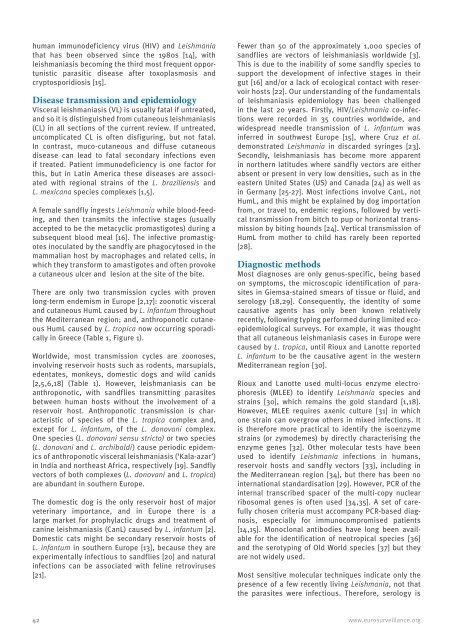Vector-borne diseases - Eurosurveillance
Vector-borne diseases - Eurosurveillance
Vector-borne diseases - Eurosurveillance
Create successful ePaper yourself
Turn your PDF publications into a flip-book with our unique Google optimized e-Paper software.
human immunodeficiency virus (HIV) and Leishmania<br />
that has been observed since the 1980s [14], with<br />
leishmaniasis becoming the third most frequent opportunistic<br />
parasitic disease after toxoplasmosis and<br />
cryptosporidiosis [15].<br />
Disease transmission and epidemiology<br />
Visceral leishmaniasis (VL) is usually fatal if untreated,<br />
and so it is distinguished from cutaneous leishmaniasis<br />
(CL) in all sections of the current review. If untreated,<br />
uncomplicated CL is often disfiguring, but not fatal.<br />
In contrast, muco-cutaneous and diffuse cutaneous<br />
disease can lead to fatal secondary infections even<br />
if treated. Patient immunodeficiency is one factor for<br />
this, but in Latin America these <strong>diseases</strong> are associated<br />
with regional strains of the L. braziliensis and<br />
L. mexicana species complexes [1,5].<br />
A female sandfly ingests Leishmania while blood-feeding,<br />
and then transmits the infective stages (usually<br />
accepted to be the metacyclic promastigotes) during a<br />
subsequent blood meal [16]. The infective promastigotes<br />
inoculated by the sandfly are phagocytosed in the<br />
mammalian host by macrophages and related cells, in<br />
which they transform to amastigotes and often provoke<br />
a cutaneous ulcer and lesion at the site of the bite.<br />
There are only two transmission cycles with proven<br />
long-term endemism in Europe [2,17]: zoonotic visceral<br />
and cutaneous HumL caused by L. infantum throughout<br />
the Mediterranean region; and, anthroponotic cutaneous<br />
HumL caused by L. tropica now occurring sporadically<br />
in Greece (Table 1, Figure 1).<br />
Worldwide, most transmission cycles are zoonoses,<br />
involving reservoir hosts such as rodents, marsupials,<br />
edentates, monkeys, domestic dogs and wild canids<br />
[2,5,6,18] (Table 1). However, leishmaniasis can be<br />
anthroponotic, with sandflies transmitting parasites<br />
between human hosts without the involvement of a<br />
reservoir host. Anthroponotic transmission is characteristic<br />
of species of the L. tropica complex and,<br />
except for L. infantum, of the L. donovani complex.<br />
One species (L. donovani sensu stricto) or two species<br />
(L. donovani and L. archibaldi) cause periodic epidemics<br />
of anthroponotic visceral leishmaniasis (‘Kala-azar’)<br />
in India and northeast Africa, respectively [19]. Sandfly<br />
vectors of both complexes (L. donovani and L. tropica)<br />
are abundant in southern Europe.<br />
The domestic dog is the only reservoir host of major<br />
veterinary importance, and in Europe there is a<br />
large market for prophylactic drugs and treatment of<br />
canine leishmaniasis (CanL) caused by L. infantum [2].<br />
Domestic cats might be secondary reservoir hosts of<br />
L. infantum in southern Europe [13], because they are<br />
experimentally infectious to sandflies [20] and natural<br />
infections can be associated with feline retroviruses<br />
[21].<br />
Fewer than 50 of the approximately 1,000 species of<br />
sandflies are vectors of leishmaniasis worldwide [3].<br />
This is due to the inability of some sandfly species to<br />
support the development of infective stages in their<br />
gut [16] and/or a lack of ecological contact with reservoir<br />
hosts [22]. Our understanding of the fundamentals<br />
of leishmaniasis epidemiology has been challenged<br />
in the last 20 years. Firstly, HIV/Leishmania co-infections<br />
were recorded in 35 countries worldwide, and<br />
widespread needle transmission of L. infantum was<br />
inferred in southwest Europe [15], where Cruz et al.<br />
demonstrated Leishmania in discarded syringes [23].<br />
Secondly, leishmaniasis has become more apparent<br />
in northern latitudes where sandfly vectors are either<br />
absent or present in very low densities, such as in the<br />
eastern United States (US) and Canada [24] as well as<br />
in Germany [25-27]. Most infections involve CanL, not<br />
HumL, and this might be explained by dog importation<br />
from, or travel to, endemic regions, followed by vertical<br />
transmission from bitch to pup or horizontal transmission<br />
by biting hounds [24]. Vertical transmission of<br />
HumL from mother to child has rarely been reported<br />
[28].<br />
Diagnostic methods<br />
Most diagnoses are only genus-specific, being based<br />
on symptoms, the microscopic identification of parasites<br />
in Giemsa-stained smears of tissue or fluid, and<br />
serology [18,29]. Consequently, the identity of some<br />
causative agents has only been known relatively<br />
recently, following typing performed during limited ecoepidemiological<br />
surveys. For example, it was thought<br />
that all cutaneous leishmaniasis cases in Europe were<br />
caused by L. tropica, until Rioux and Lanotte reported<br />
L. infantum to be the causative agent in the western<br />
Mediterranean region [30].<br />
Rioux and Lanotte used multi-locus enzyme electrophoresis<br />
(MLEE) to identify Leishmania species and<br />
strains [30], which remains the gold standard [1,18].<br />
However, MLEE requires axenic culture [31] in which<br />
one strain can overgrow others in mixed infections. It<br />
is therefore more practical to identify the isoenzyme<br />
strains (or zymodemes) by directly characterising the<br />
enzyme genes [32]. Other molecular tests have been<br />
used to identify Leishmania infections in humans,<br />
reservoir hosts and sandfly vectors [33], including in<br />
the Mediterranean region [34], but there has been no<br />
international standardisation [29]. However, PCR of the<br />
internal transcribed spacer of the multi-copy nuclear<br />
ribosomal genes is often used [34,35]. A set of carefully<br />
chosen criteria must accompany PCR-based diagnosis,<br />
especially for immunocompromised patients<br />
[14,15]. Monoclonal antibodies have long been available<br />
for the identification of neotropical species [36]<br />
and the serotyping of Old World species [37] but they<br />
are not widely used.<br />
Most sensitive molecular techniques indicate only the<br />
presence of a few recently living Leishmania, not that<br />
the parasites were infectious. Therefore, serology is<br />
42 www.eurosurveillance.org

















